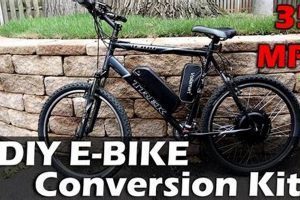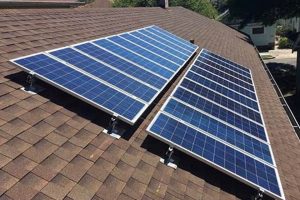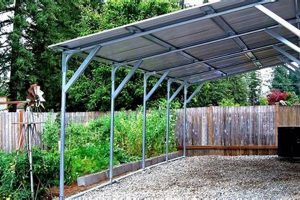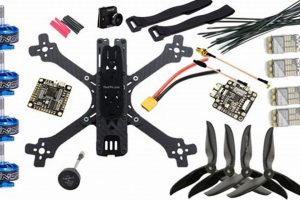A self-assembly package providing the components and instructions necessary to construct a photovoltaic energy system is designed for individuals seeking to harness solar power. These packages typically include solar panels, an inverter, wiring, mounting hardware, and detailed manuals, enabling users to create functional solar energy solutions.
The adoption of self-built solar energy systems offers several advantages, including cost savings, educational opportunities, and increased energy independence. Historically, these systems have empowered individuals and communities to generate their own electricity, reducing reliance on traditional power grids and fostering a more sustainable approach to energy consumption. The ability to control one’s energy source provides resilience and aligns with environmental stewardship principles.
The subsequent sections will delve into the specific components of these systems, address safety considerations, explore installation best practices, and discuss the potential for long-term energy savings and environmental impact reduction.
Solar DIY Kit
Successful implementation of a solar DIY kit requires careful planning and adherence to best practices. The following tips aim to provide critical guidance throughout the process.
Tip 1: Assess Energy Needs Accurately: Before selecting a solar DIY kit, quantify your household’s or business’s energy consumption. Review past utility bills to determine average kilowatt-hour usage. This assessment dictates the appropriate size and capacity of the solar panel system required.
Tip 2: Conduct a Thorough Site Survey: Evaluate the installation location’s suitability. Assess roof orientation, shading from trees or adjacent buildings, and structural integrity. Optimal solar panel performance necessitates maximum sunlight exposure and a secure mounting surface.
Tip 3: Prioritize Safety Precautions: Working with electricity demands strict adherence to safety protocols. De-energize circuits before wiring and wear appropriate personal protective equipment (PPE), including gloves and safety glasses. Consult with a qualified electrician if uncertain about any aspect of the electrical connections.
Tip 4: Adhere to Local Codes and Regulations: Research local building codes and regulations pertaining to solar panel installations. Permits may be required, and adherence to specific standards is often mandated. Contact the local permitting office to ensure compliance.
Tip 5: Use Quality Components: Opt for solar DIY kits that include high-quality components from reputable manufacturers. Inferior components can compromise system performance and longevity. Prioritize panels with high efficiency ratings and inverters with robust surge protection.
Tip 6: Follow the Instructions Meticulously: Adhere strictly to the instructions provided with the solar DIY kit. Deviations from the recommended installation procedures can lead to malfunctions, reduced efficiency, or safety hazards. Consult the manufacturer’s documentation for troubleshooting assistance.
Tip 7: Monitor System Performance: After installation, monitor the system’s performance regularly. Use monitoring software or hardware provided with the kit to track energy production and identify any anomalies. Early detection of issues allows for timely corrective action.
These guidelines are designed to maximize the effectiveness and safety of implementing a solar DIY kit. Diligence and meticulous execution are essential for achieving the desired outcomes.
The subsequent sections will address the environmental and financial implications of utilizing self-installed solar energy systems.
1. Component Selection
The selection of components for a solar DIY kit is paramount to the system’s overall efficiency, longevity, and safety. Inadequate component choices can lead to diminished energy production, premature failures, and potential hazards, underscoring the importance of informed decision-making.
- Solar Panels
Solar panels are the core of a photovoltaic system, converting sunlight into electricity. Selection criteria include power rating (wattage), efficiency, cell type (monocrystalline, polycrystalline, thin-film), and manufacturer warranty. Higher efficiency panels maximize energy production in limited space. Monocrystalline panels typically offer superior performance but are more expensive. The panels power output directly determines the systems overall capacity. For example, selecting 300W panels over 250W panels, for the same array size, will result in significantly more energy generation.
- Inverter
The inverter converts the direct current (DC) electricity produced by the solar panels into alternating current (AC) electricity, which is compatible with most household appliances and the electrical grid. Inverter types include string inverters, microinverters, and hybrid inverters. String inverters are cost-effective but susceptible to shading effects on system performance. Microinverters, attached to each panel, mitigate shading issues and enable individual panel monitoring. Hybrid inverters integrate battery storage capabilities. The inverter’s continuous power rating must match or exceed the solar panel array’s output to avoid overloading and ensure stable operation. A failure to choose the right size inverter can lead to system shutdowns and damage.
- Wiring and Connectors
The wiring and connectors used in a solar DIY kit must be appropriately sized and rated for outdoor use and high voltage/current applications. These components facilitate the flow of electricity between panels, the inverter, and the electrical grid. Undersized wiring can cause voltage drops, reducing system efficiency and potentially creating fire hazards. Weather-resistant connectors are crucial for preventing corrosion and maintaining reliable electrical connections in harsh environments. Using certified, UV-resistant wiring is critical for long-term safety and performance.
- Mounting Hardware
The mounting hardware secures the solar panels to the roof or ground, providing stability and resistance to wind and weather. The hardware must be compatible with the specific roof type and capable of withstanding local wind and snow loads. Inadequate mounting can lead to panel detachment, roof damage, and system failure. Corrosion-resistant materials, such as aluminum or stainless steel, are essential for longevity. Proper grounding of the mounting system is critical for electrical safety and to prevent lightning damage.
Careful consideration of each component’s specifications, compatibility, and quality ensures that the solar DIY kit delivers reliable performance and meets the user’s energy needs. A system built with subpar components will invariably underperform and require more frequent maintenance, negating the potential cost savings associated with self-installation.
2. System Sizing
System sizing is a crucial determinant of a solar DIY kit’s efficacy. Mismatched sizing yields suboptimal energy production or unnecessary expense. An undersized system fails to meet energy demands, requiring continued reliance on conventional power sources. Conversely, an oversized system incurs unwarranted costs and potential energy waste if generated power exceeds consumption. Appropriate system sizing directly correlates with the ability to achieve energy independence and realize the financial benefits of self-generated solar power. For example, a household consuming an average of 1000 kWh per month necessitates a larger system than one consuming only 500 kWh per month to offset grid reliance fully.
Accurate system sizing requires a thorough evaluation of energy consumption patterns, geographic location, and available sunlight hours. Energy audits provide data on historical usage, informing the kilowatt-hour requirement for the solar system. Geographic location dictates the amount of solar irradiance, influencing panel output. Locations with higher solar irradiance require fewer panels to generate the same amount of electricity. Shade analysis is also vital; shaded areas diminish panel output, necessitating adjustments in array size or panel placement. Tools such as solar calculators and professional consultations can assist in precise system sizing, optimizing the solar DIY kit’s performance.
Properly sized solar DIY kits enhance energy independence and yield significant financial savings. Incorrectly sized systems underperform or waste resources. Understanding the correlation between energy needs, location-specific factors, and solar system capacity is paramount for maximizing the return on investment in renewable energy solutions.
3. Installation Safety
The integration of safety protocols during the installation of self-assembly photovoltaic systems is paramount, influencing both the immediate well-being of the installer and the long-term operational integrity of the system. Improper installation practices can lead to electrical shock, falls from heights, and structural damage, underscoring the critical connection between a properly executed procedure and the mitigation of inherent risks. For example, failure to disconnect the main power supply before wiring the inverter can result in severe electrical injury or even death. Ignoring the structural integrity of the mounting surface can lead to panel detachment and potential harm to individuals and property.
A comprehensive safety regimen encompasses several key elements. These include the use of appropriate personal protective equipment (PPE), such as insulated gloves, safety glasses, and fall protection harnesses when working at elevated heights. Adherence to electrical safety codes, including grounding procedures and proper wiring techniques, is non-negotiable. Furthermore, thorough understanding of the solar DIY kit’s instructions and schematics is essential to prevent misconnections and potential hazards. A real-world illustration is the implementation of lockout/tagout procedures to ensure the system is de-energized during maintenance or troubleshooting. Such protocols minimize the risk of accidental energization and subsequent injury.
In conclusion, installation safety is not merely an ancillary consideration, but an intrinsic element of any solar DIY kit deployment. Neglecting safety measures carries significant consequences, ranging from personal injury to system failure. The implementation of rigorous safety protocols, coupled with a comprehensive understanding of electrical and structural principles, ensures a safe and reliable self-assembly photovoltaic system. The convergence of knowledge, caution, and adherence to best practices represents the cornerstone of successful and safe solar energy adoption.
4. Permitting Requirements
The necessity of obtaining proper permits forms a critical intersection in the implementation of self-installed photovoltaic systems. Adherence to established regulatory frameworks is not merely procedural; it is a fundamental requirement for ensuring safety, structural integrity, and legal compliance within local jurisdictions. The absence of proper permitting can lead to legal repercussions, fines, and the potential forced removal of the installed system.
- Electrical Safety Inspections
Most jurisdictions mandate electrical safety inspections for solar installations to verify compliance with the National Electrical Code (NEC) or equivalent local standards. These inspections ensure that wiring, grounding, and protective devices meet stringent safety requirements, mitigating the risk of electrical hazards. For example, an inspector will verify proper conductor sizing, overcurrent protection, and the correct installation of disconnect switches. Failure to pass inspection necessitates corrective actions, often incurring additional expenses and delaying system operation.
- Structural Load Assessments
Local building codes often require a structural engineer to assess the load-bearing capacity of the roof or mounting structure supporting the solar panels. This assessment verifies that the structure can withstand the added weight of the system, as well as wind and snow loads, preventing structural failure. For instance, in areas prone to heavy snowfall, a structural engineer will calculate the maximum snow load and ensure that the roof can support it, along with the weight of the panels and mounting hardware.
- Grid Interconnection Agreements
If the self-installed photovoltaic system is designed to connect to the electrical grid for net metering or selling excess energy, an interconnection agreement with the local utility is typically required. This agreement outlines the technical and safety standards for connecting the system to the grid, ensuring that the system does not negatively impact grid stability. Utilities often require specific equipment, such as certified inverters with anti-islanding protection, to prevent the system from feeding power back into the grid during outages.
- Zoning and Land Use Regulations
Local zoning and land use regulations can impose restrictions on the placement and aesthetics of solar panels. These regulations may dictate setbacks from property lines, height restrictions, and visual appearance requirements, ensuring that the system is compatible with the surrounding environment. For example, a homeowners association may have rules regarding the visibility of solar panels from the street, requiring them to be placed on the rear of the roof or screened from view.
The fulfillment of these permitting requirements ensures that self-installed photovoltaic systems meet necessary safety and structural standards, promoting long-term reliability and preventing potential hazards. While navigating the permitting process can be complex, adherence to these regulations is crucial for realizing the full benefits of renewable energy while protecting public safety and property.
5. Performance Monitoring
Effective performance mon
itoring is an indispensable component of a self-installed photovoltaic system. It bridges the gap between theoretical energy production and actual system output, providing essential data for assessing efficiency, identifying potential issues, and optimizing long-term performance. Neglecting performance monitoring equates to operating the system blindly, with potential for undetected malfunctions and suboptimal energy harvesting. Real-world examples illustrate this: a gradual decline in energy production due to shading or panel degradation might go unnoticed without monitoring, leading to sustained losses in energy savings. Similarly, inverter inefficiencies or wiring faults could remain hidden, compromising system performance and potentially creating safety hazards. The ability to track energy generation, identify trends, and respond to anomalies directly impacts the return on investment in a solar DIY kit.
Performance monitoring systems typically involve hardware components like energy meters, data loggers, and communication interfaces, paired with software platforms for data visualization and analysis. These systems provide granular insights into key performance indicators (KPIs) such as daily energy production, inverter efficiency, voltage and current levels, and system uptime. Analyzing these metrics allows users to detect deviations from expected performance, diagnose potential problems, and implement corrective measures. For instance, if the system exhibits a sudden drop in energy production on a clear day, monitoring data can pinpoint the cause, whether it’s a panel malfunction, inverter issue, or grid connectivity problem. Furthermore, long-term performance data informs maintenance schedules and enables proactive interventions to prevent costly repairs or system downtime.
In summary, performance monitoring is not a mere add-on, but an integral element of a self-installed solar system. It enables proactive management, optimizes energy harvesting, and safeguards the system against potential issues. While initial investment in monitoring equipment and software may seem like an additional cost, the long-term benefits in terms of energy savings, system longevity, and problem prevention far outweigh the expense. Addressing challenges in data interpretation or system integration is essential to fully leverage the power of performance monitoring for maximizing the efficiency and profitability of a solar DIY kit.
6. Financial Viability
The evaluation of financial viability is paramount when considering a self-installed photovoltaic system. The upfront investment in a solar DIY kit represents a significant expenditure, necessitating a thorough analysis of potential returns. Several factors influence the financial feasibility, including the initial cost of the kit, installation expenses (if professional assistance is required), available incentives (tax credits, rebates, and net metering policies), energy consumption patterns, and the cost of electricity from the local utility grid. A comprehensive assessment considers these variables to determine the payback period, return on investment (ROI), and overall long-term cost savings. For example, a higher initial investment may be justified if the system qualifies for substantial tax credits and significantly reduces reliance on expensive grid electricity, resulting in a shorter payback period and higher ROI.
Quantifying the financial benefits requires a detailed understanding of local energy prices and consumption habits. An increase in utility rates elevates the value proposition of self-generated solar energy, accelerating the payback period and enhancing ROI. Net metering policies, where excess solar energy is fed back into the grid in exchange for credits or payment, further improve financial viability. Conversely, unfavorable net metering arrangements or declining electricity prices can extend the payback period, potentially reducing the attractiveness of the investment. Maintenance costs, while typically lower than traditional energy systems, should also be factored into the financial analysis. Regular cleaning, occasional component replacements, and potential inverter repairs represent ongoing expenses that can impact long-term profitability.
In conclusion, assessing financial viability demands a rigorous, data-driven approach. A comprehensive evaluation encompasses not only the initial costs but also the long-term financial benefits, considering incentives, energy prices, and maintenance expenses. This holistic perspective enables informed decision-making, ensuring that the investment in a solar DIY kit aligns with individual financial goals and delivers a favorable return over its operational lifespan. Neglecting this critical step can result in an economically unsound investment, underscoring the importance of diligent financial planning prior to embarking on a self-installed solar energy project.
Frequently Asked Questions About Solar DIY Kit
This section addresses common inquiries concerning the acquisition, installation, and operation of self-installed photovoltaic systems. The information provided aims to clarify essential aspects for prospective adopters of this technology.
Question 1: What are the primary components included in a typical Solar DIY Kit?
A standard package incorporates photovoltaic panels, an inverter (to convert DC to AC power), mounting hardware, wiring, connectors, and detailed installation instructions. Battery storage systems may be included or available as optional add-ons.
Question 2: Does assembling a Solar DIY Kit require specialized expertise?
While prior electrical or construction experience is beneficial, a kit designed for do-it-yourself installation aims to simplify the process. However, familiarity with basic electrical concepts and safety procedures is essential. Consultation with a qualified electrician is recommended for complex installations or if uncertainties arise.
Question 3: What are the potential cost savings associated with installing a Solar DIY Kit?
Cost savings are derived from reduced reliance on grid-supplied electricity, potentially leading to lower monthly utility bills. The magnitude of savings depends on factors such as system size, energy consumption patterns, local electricity rates, and available government incentives. Long-term savings often offset the initial investment cost.
Question 4: Are there specific safety precautions to consider during Solar DIY Kit installation?
Stringent adherence to safety guidelines is imperative. Key precautions include disconnecting the main power supply before working with electrical components, using appropriate personal protective equipment (PPE), ensuring proper grounding, and following the manufacturer’s instructions meticulously. Deviation from these procedures can result in serious injury or equipment damage.
Question 5: What are the common challenges encountered during Solar DIY Kit installation?
Typical challenges include accurately assessing energy needs, ensuring proper roof orientation and shading analysis, navigating local permitting requirements, and connecting the system to the electrical grid. Careful planning and preparation can mitigate these difficulties.
Question 6: How can the performance of a self-installed Solar DIY Kit be monitored and optimized?
Performance monitoring systems, often included with the kit or available separately, provide data on energy production, system efficiency, and potential malfunctions. Regular monitoring allows for timely detection of issues,
enabling corrective actions to optimize energy output and prolong system lifespan.
The responses provided aim to address fundamental queries regarding the adoption of self-installed photovoltaic systems. Careful consideration of these factors is crucial for successful implementation.
The subsequent section explores potential future developments in the realm of self-assembly solar energy solutions.
Conclusion
This exposition has illuminated the multifaceted nature of the “solar diy kit,” encompassing essential considerations from component selection and system sizing to installation safety, permitting prerequisites, performance monitoring, and financial implications. A thorough understanding of these elements is crucial for individuals contemplating the adoption of self-installed photovoltaic systems. Careful planning and meticulous execution are vital for realizing the potential benefits of renewable energy generation.
As technology evolves and regulatory landscapes shift, continued diligence in staying informed about best practices and emerging standards remains paramount. The conscientious pursuit of knowledge and adherence to established guidelines will optimize the effectiveness and longevity of “solar diy kit” installations, contributing to a more sustainable energy future.







